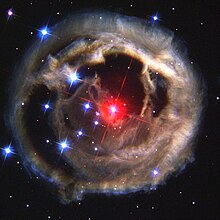Light echo

A light echo is an echo-like, time-shifted scattering of light on interstellar gas and dust, which was emitted by a star during a brief flash of brightness, such as a nova or supernova . The clouds of gas and dust visible through the scattering were partly repelled by the star during previous eruptions or are part of the interstellar matter . As seen by the observer, the light echo spreads concentrically around the star, since the indirect path of the scattered light increases with increasing distance from the star and thus the arrival time with the observer becomes later and later.
The first discovery of a light echo took place in 1901 at Nova Persei in 1901 . This phenomenon became particularly well-known on the occasion of a strong outburst of brightness of the luminous red Nova V838 Monocerotis on January 1, 2002, which subsequently generated a strong light echo that moved concentrically outwards over the years.
With the help of light echoes you can
- the structure of circumstellar matter is analyzed around an optical transient,
- spectrographic investigations of historical nova and supernova outbreaks are carried out,
- Observations of the course of brightness of historical nova and supernova outbreaks are analyzed, and
- the distance or the age of the light outbreak can be derived from the apparent speed of the propagation of the light echo.
The analysis of light echoes has only become possible on a large scale through the use of CCD sensors , which are orders of magnitude more sensitive to light than photographic techniques. Light echoes can also interfere with the analysis of the spectra of objects that are rapidly diminishing in light. So far, light echoes have been detected around supernovae , novae , luminous red novae , luminous blue variable , T-Tauri stars and Herbig-Haro stars.
RS Puppis
With the help of a light echo, an international group of astronomers has succeeded in determining the distance of the Cepheid RS Pup from the earth with great accuracy. In a dust nebula surrounding the star, its brightness pulsations are reflected with a corresponding time delay. Measuring this delay at different parts of the nebula showed a distance of 6500 light years . The uncertainty was only 90 light years, since this method is based solely on geometrical relationships and the speed of light .
Tycho's supernova
In the case of Supernova 1572 , the supernova could be examined spectrographically based on the light echo and clearly assigned to class Ia.
literature
- A. Rest, B. Sinnott, DL Welch: Light Echoes of Transients and Variables in the Local Universe . In: Astrophysics. Solar and Stellar Astrophysics . 2012, arxiv : 1204.1341 .
Web links
Individual evidence
- ↑ Light echo reveals star distance . Scienceticker.info, February 11, 2008
- ↑ Supernova: Astronomers spot a 400-year-old star explosion . Mirror online
